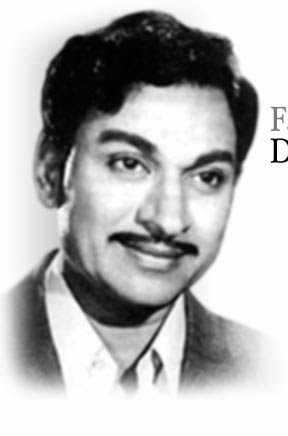Do
you know about our national poet? His journey of love lasted as long as she
lived. Our poet D.R.Bendre did not say any less about her. He wrote
SakheeGeeta. K.S.N became old trying to find her, the daughter of a Shanubhoga,
(a Brahmin who does the work of a village accountant) in leat, banana and lemon
orchards. We don’t know if he gave her Mysore Jasmine. Harivamsharaya Bachchan,
who worshipped her in his Madhubala, MadhuShala and Madhupyala, was clammed mad
about her. Vincent Vinci who cut his beautiful ears, wrapped them in a piece of
canvas and gave her asking her what gift he should give, the English poet
W.B.Yeats who whispered into her ears “tread softly, my love, because you are
walking on my dreams”, all these artists, I think, have gone in search of her
but they have not seen her. Who is ‘she’ that slips away like that?
What a pain that I suffered that
evening! My mother told me ‘she died of blood cancer’ ‘who?’ I asked. She told
me “That female child who played on my plam, who warmed your limbs, caused the
blood to flow to your cheeks, is now no more.” She continues to talk about her.
I looked deep into my mother’s eyes. In her eyes ‘her’ fire was burning. But
she was not burning. Our tomorrows will be a shade less excruciating if she
were to die once for all, won’t they? I think that Death becomes meaningless if
it were to attack her. How can she be liquidated by Death when she is after the
deathless, formless and harmless man standing on the burning bed of straw on
the water? Language becomes utter pointless whenever I think of her. Women of
different kinds-of physical structure, of language, of beauty have entered into
my life. I address all of them as ‘she’. ‘She’ becomes totally essential to
language but not to emotions. In language ‘she’ is treated as ‘she’ but ‘she’
is a child in the form of a seed in the womb. ‘She’ is still very young in my
mind as waiting for her customers by the shade of a chimney in front of my
school as evening approaches. But ‘she’, holding wine glasses of different
colors, arousing you sexually in the bedrooms of your veins, dancing, has not
been affected by time.
Who is ‘she’, who played all
possible roles in my life, who is present at every step in the journey of my
life but who remained as a buried treasure without being available to the quest
called research?
The more I ask this question, the
more complicated ‘she’ becomes. ‘She’ can even get her sex changed. You may not
believe if I say that ‘she’ was present in the food that was served by my
grandfather, in the made love of my brother, in the pure love of fans, in the
happiness of students, in the affection of a teacher who used to come from a
distant place and in the innocent smile of my brother’s new born child. I can
say with certainly that ‘she’ is present in the jasmine flower, in the books
that I pick up with love, in the pillow on which I lie, in the ruined sinking
stone pillars of Hampi. I can talk to ‘her’. I can tune in to ‘her’ voice’; I
can plant myself in ‘her’ womb. But, still who is ‘she’? I just cannot say.
‘She’ is not just kumkum, not a nose-ring or ring worn on the toes, not a saari,
nor a Sanyasini in the mundane world.
Let us relate the story of a young
man of our family who went to see God. He quarreled, left the house, abandoned
my sister whom he had married in accordance with the scriptures, left the town,
and grew a beard, wandered from forest to forest for a decade. Punishing his
body he tried to prove that he was beyond ‘her’. When he returned home, one
day, all of a sudden, he went mad. He was born again and again around the
fragrance of ‘her’ heart like a moth that dies trying to catch fire. He might
have found life meaningless without ‘her’. Or he might have misunderstood
‘her’, thought of ‘her’ as an obstacle in realizing the aim of his life.
 He had 12 children from ‘her’. He
often met other women after he had abandoned my sister. He is still meeting
them. My argument is that he did not get ‘her’. ‘She was neither an obstacle in
his way in the beginning of his life, nor was ‘she’ the woman who satisfied his
growing desire for sex in his later years. ‘She’ was merely the scapegoat of
his limited vision that is all.
He had 12 children from ‘her’. He
often met other women after he had abandoned my sister. He is still meeting
them. My argument is that he did not get ‘her’. ‘She was neither an obstacle in
his way in the beginning of his life, nor was ‘she’ the woman who satisfied his
growing desire for sex in his later years. ‘She’ was merely the scapegoat of
his limited vision that is all.
I now feel that because of the
limitation of my emotion and intelligence, I tried to catch ‘her’ with my
language and conceptual imagination. The more I try to express ‘her’ in
language, the more significant forms ‘she’ talks on.
How can I say that ‘she’ will not be
misunderstood when we describe ‘her’ as merely ‘she’ just as we misunderstand
when we say earth as merely earth and light as merely light? We understand
according to the twist of meaning because we have always viewed everything
within the parameters of meaning. But, we must know, that the misinterpretation
and twist of ‘her’ is the first step towards getting a vision of the truth
about ‘her’.














